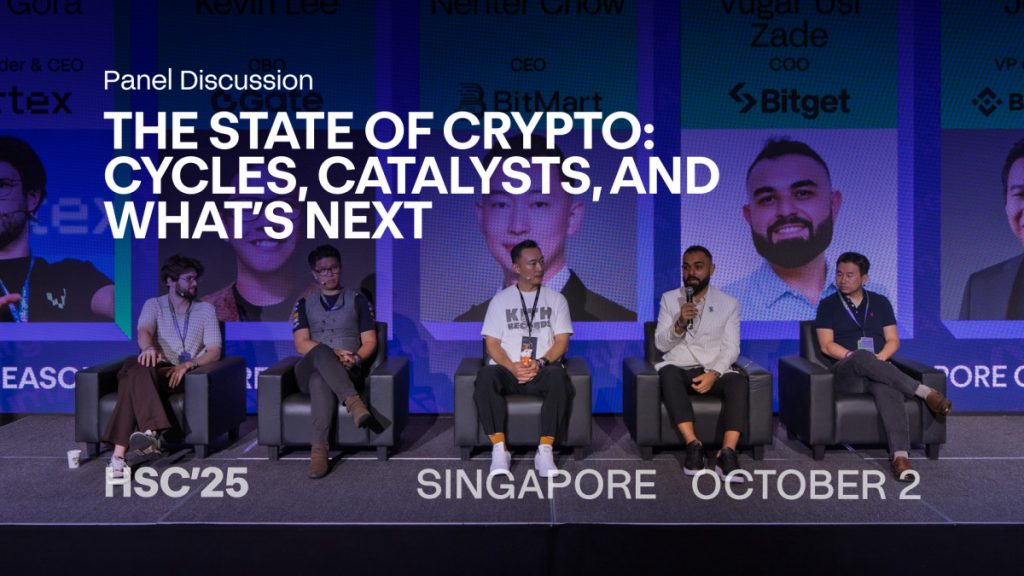Market Cycles, Emerging Trends, And Evolving Strategies: Experts Discuss The Future Of Crypto Exchanges At Hack Seasons Singapore


In Brief
At Hack Seasons Singapore, industry leaders discussed how exchanges are evolving into all-in-one platforms, the growing role of stablecoins, DeFi, and AI, and the need for sustainable business models to drive mainstream crypto adoption.

At the start of October, the Hack Seasons Conference in Singapore brought together prominent figures from the digital asset sector to discuss the current landscape and future direction of the industry. The session, titled “The State of Crypto: Cycles, Catalysts, and What’s Next,” was moderated by Gleb Gora, Co-Founder and CEO of Vortex. The main stage panel included representatives from major cryptocurrency exchanges, featuring Kevin Lee, Chief Business Officer at Gate, Nether Chow, Chief Executive Officer of BitMart, Vugar Usi Zade, Chief Operating Officer of Bitget, and Jeff Li, Vice President of Product at Binance.
The discussion opened with an examination of the key narratives and trends shaping the current market cycle and what major exchanges are focusing on. One speaker noted that exchanges have evolved beyond their traditional role, with many platforms now launching additional products such as Layer 2 solutions, perpetual decentralized exchanges (DEXs), and stablecoins. This expansion is driven by the goal of keeping users within a single ecosystem, particularly as DEXs continue to capture market share. Centralized exchanges (CEXs) are responding by broadening their scope and functionality.
Panelists agreed that modern exchanges must function as all-in-one platforms, capable of serving users across different segments of the market. As user behavior diversifies, exchanges are adapting to meet a wider range of needs, offering both trading and non-trading financial services under one roof.
In addition to expanding their service offerings, exchanges are also positioning themselves as payment gateways—what some described as the “crypto version of Stripe.” Facilitating everyday spending was identified as one of the most significant narratives driving growth, as this area presents the greatest potential for onboarding the next billion users. The integration of payment functionality supports the broader vision of enabling “life on-chain,” reflecting a shift where being on-chain becomes as natural as being online.
Speakers also highlighted emerging trends such as the accelerating participation of institutional investors, which could help stabilize market volatility. Other key developments include the growth of stablecoins and real-world assets (RWA), as well as the intersection of artificial intelligence (AI) and blockchain technology. The convergence of AI and crypto was identified as a major transformative force likely to define the next four to five years. Additionally, decentralized finance (DeFi) and the rise of perpetual DEXs were recognized as crucial components in shaping the next stage of technological evolution.
The discussion then turned to whether retail investors are moving toward decentralized products or if exchanges can attract users back through improved DeFi integrations. Panelists observed that retail users tend to pursue the next major opportunity, often seeking fast-paced investment options, early trading access, and high leverage. Providing fair, accessible platforms that meet these expectations was described as essential to sustaining engagement.
The conversation emphasized the momentum-driven nature of the cryptocurrency industry, contrasting the speculative tendencies of retail investors with the more strategic approach of institutions. Understanding where demand originates was seen as crucial, as attracting retail users often depends on offering opportunities for high returns.
For over a decade, cryptocurrency has been marketed around the promise of exponential gains—10x, 20x, or even 100x returns—creating an ingrained expectation among retail participants. This mindset persists even during bear markets, where interest often shifts toward memecoins or other high-risk assets. While tokenized stocks and perpetual DEXs reflect similar speculative behavior, panelists noted that the industry must also focus on building tools that serve broader, more sustainable purposes.
Institutional investors, on the other hand, now enter the market primarily for diversification and hedging rather than rapid profit. This marks a clear divergence in mindset between retail and institutional participants. Beyond market decoupling—such as Bitcoin’s performance relative to traditional assets—there is also a growing divide in investor behavior and objectives. The panel agreed that future development should focus on creating solutions that address the differing needs of both groups.
Speakers concluded by noting that as banks, exchange-traded funds (ETFs), and traditional financial institutions expand their involvement in digital assets, competition will intensify not only for user attention but also for customer capital. In this landscape, trust, functionality, and the ability to empower users within a comprehensive ecosystem will determine where individuals choose to hold and manage their funds.
Emerging Funding Models In Crypto: Tokens, Transparency, And The Role Of VCs
The panel also explored whether there could be alternatives to traditional venture capital (VC) funding in the current cycle and what new catalysts might drive capital inflows for emerging projects.
Speakers observed that launching proprietary tokens has become increasingly common as a funding mechanism. This approach provides projects with more options beyond traditional equity financing. While VCs continue to invest in equity, the rise of fair-launch platforms and token launchpads allows projects to raise capital directly from the market. These new avenues were described as offering broader opportunities than many other sectors currently provide.
Panelists noted that the current market is characterized by an oversupply of crypto-focused venture capital firms, many of which may not endure through future cycles. The absence of significant barriers to token creation means that new tokens can be launched easily and frequently. However, limited natural demand among retail investors often prevents these tokens from sustaining long-term value. The discussion highlighted growing expectations that the next wave of projects will prioritize sustainable business models over purely speculative tokenomics. As a result, greater transparency and sound economic design are becoming increasingly important.
Other speakers emphasized that, despite these shifts, the industry still relies heavily on venture capital. Early-stage projects tend to perform better when supported by experienced investors who can provide strategic guidance in addition to funding. In traditional Web2 markets, VC involvement was viewed as a form of validation, as investors typically conducted due diligence before committing capital. In the Web3 environment, this dynamic has evolved, with many venture firms operating with more flexible and liquid funding models. However, the panel noted that an increasing number of VC firms now function largely as brand names without offering substantive support, which remains one of the key challenges for sustainable growth in the sector.
Disclaimer
In line with the Trust Project guidelines, please note that the information provided on this page is not intended to be and should not be interpreted as legal, tax, investment, financial, or any other form of advice. It is important to only invest what you can afford to lose and to seek independent financial advice if you have any doubts. For further information, we suggest referring to the terms and conditions as well as the help and support pages provided by the issuer or advertiser. MetaversePost is committed to accurate, unbiased reporting, but market conditions are subject to change without notice.
About The Author
Alisa, a dedicated journalist at the MPost, specializes in cryptocurrency, zero-knowledge proofs, investments, and the expansive realm of Web3. With a keen eye for emerging trends and technologies, she delivers comprehensive coverage to inform and engage readers in the ever-evolving landscape of digital finance.
More articles

Alisa, a dedicated journalist at the MPost, specializes in cryptocurrency, zero-knowledge proofs, investments, and the expansive realm of Web3. With a keen eye for emerging trends and technologies, she delivers comprehensive coverage to inform and engage readers in the ever-evolving landscape of digital finance.


















































